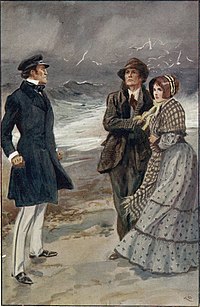The Pavilion on the Links

"The Pavilion on the Links" (1880) is a short story by Robert Louis Stevenson. It was first published in Cornhill Magazine (Vol. 42, Sept-Oct 1880).[1] A revised version was included in New Arabian Nights (1882).[2]
The story was considered by Sir Arthur Conan Doyle in 1890 as "the high-water mark of [Stevenson’s] genius" and "the first short story in the world".[3] Along with a number of other stories it was collected in a volume entitled New Arabian Nights in 1882. This collection is seen as the starting point for the history of the English short story by Barry Menikoff.[4]
Adaptations
[edit]The White Circle, a silent film, was released in 1920, starring Spottiswoode Aitken as Bernard Huddlestone, Janice Wilson as Clara Huddlestone, Harry Northrup as Northmour, and John Gilbert as Frank Cassilis.
State of Siege, episode 16 of season 4 of the TV series Maverick, borrows the actual siege and the host engaged to the daughter of the wanted man, but little else of the story, which it re-situates in the New Mexico Territory as a dispute between Spanish landowners.[5]
The Pavilion, a direct-to-video release, came out in 1999, starring Craig Sheffer as Frank Cassilis, Patsy Kensit as Clara Huddlestone, Richard Chamberlain as Huddlestone, and Daniel Riordan as Northmour.
Notes
[edit]- ^ "The Pavilion on the Links," Part II, The Cornhill Magazine, Vol. XLII, 1880; The Cornhill version is reprinted in Treasure Island; The New Arabian Nights ed. with an introd. by M. R. Ridley: London/NY: Dent/Dutton (Everyman’s Library). 1962.
- ^ "Stevenson published The Pavilion on the Links in the Cornhill Magazine, in the issues for September and October 1880; two years later, in 1882, he included it in his New Arabian Nights. There is one glaring difference between the two editions: in the first, the story appears as a letter and testament which an old father, as death closes in, leaves for his sons in order to reveal a family secret to them: namely, how he met their mother, who is already dead. In the rest of the text the narrator addresses the readers with the vocative, 'my dear sons', calls the heroine, 'your mother', 'your dear mother', 'the mother of my sons' and call the sinister character, her father, 'your grandfather.' The second version, in book form, goes straight into narration from the first sentence: 'I was a great solitary when I was young'; the heroine is called 'my wife' or by her name, Clara, and the old man is called 'her father' or Huddlestone. This shift usually means a completely different style, indeed a completely different kind of story; instead the corrections are minimal: the excision of the preamble, of the address to the sons, and of the more grief-stricken references to the mother. Everything else remains exactly the same." — Calvino, Italo (1999). Why Read the Classics? New York: Pantheon Books, p. 171.
- ^ Hammerton, J.A. (1903). Stevensoniana. London: Grant Richards, p. 241.
- ^ RLS - biography
- ^ "State of Siege". Internet Movie Database. Retrieved 19 October 2014.
External links
[edit]- "The Pavilion on the Links", illustrated by Gordon Browne. 1913.
- The White Circle at IMDb
- The Pavilion at IMDb
 The Pavilion on the Links public domain audiobook at LibriVox
The Pavilion on the Links public domain audiobook at LibriVox
